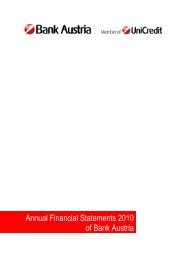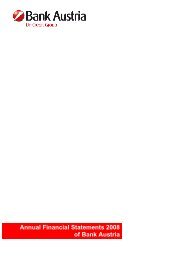Annual Financial Statements 2011 of Bank Austria
Annual Financial Statements 2011 of Bank Austria
Annual Financial Statements 2011 of Bank Austria
Create successful ePaper yourself
Turn your PDF publications into a flip-book with our unique Google optimized e-Paper software.
Management Report<br />
Management Report (CONTINUED)<br />
The major challenges facing the banks (buildup <strong>of</strong> additional<br />
risk buffers, difficult funding conditions, management <strong>of</strong> liquidity<br />
ratios) led to high and rising interest rates on bank deposits in<br />
the second half <strong>of</strong> <strong>2011</strong> (while money market or capital market<br />
rates recently declined). Given the uncertainty surrounding the<br />
debt crisis, deposits in <strong>Austria</strong> rose by over 3%. Deposits from<br />
private customers increased by close to 2% and accounted for<br />
about one-half <strong>of</strong> additions to financial assets held by private<br />
households, slightly more than a year earlier. In 2012, monetary<br />
capital formation could be somewhat more pronounced, mainly<br />
as a result <strong>of</strong> more favourable trends in real incomes while<br />
inflation will decline. At the current very low valuation levels in<br />
some areas, capital markets <strong>of</strong>fer attractive investment opportunities.<br />
But on the other hand, given the strains on bank funding,<br />
deposit interest rates are also attractive.<br />
� Countries in Central and Eastern Europe (CEE) were also<br />
affected by the deterioration in the global economic environment<br />
in the second half <strong>of</strong> <strong>2011</strong> and around the turn <strong>of</strong> the year.<br />
Overall, however, the region continued to pursue sound expansion.<br />
As the European debt crisis escalated, risk aversion again<br />
became more pronounced. But given the relatively low levels <strong>of</strong><br />
government debt in the region, CEE coped well with this situation.<br />
CDS spreads on government bonds <strong>of</strong> CEE countries (Traxx<br />
SovX CE), which tracked the West European CDS index up to the<br />
peak <strong>of</strong> 386 bp in November, have in the meantime decoupled<br />
from this trend and are now significantly lower, at 282 bp (Traxx<br />
SovX Western Europe: most recently 353 bp).<br />
The surprisingly high level <strong>of</strong> industrial output and expectations<br />
<strong>of</strong> an easing <strong>of</strong> the EMU crisis have prompted our economists to<br />
raise their growth forecasts for 2012 and 2013 by 0.3 percentage<br />
points for both years. But developments in the euro area<br />
will continue to be among the factors determining trends in the<br />
CEE region, via multiple transmission paths, later in 2012:<br />
First, via real economy links: we expect that weak economic<br />
trends in the first half <strong>of</strong> 2012 will affect regions and countries<br />
in CEE to varying degrees, depending on their foreign trade<br />
orientation and product mix, before the second half <strong>of</strong> the year<br />
sees a recovery. The closely integrated Central European countries,<br />
in particular, will have to overcome a period <strong>of</strong> lower<br />
growth in the first half <strong>of</strong> 2012, all the more so as domestic<br />
demand will also be weak, reflecting pressure to consolidate<br />
public finances. Slovenia will again slide into recession (2012:<br />
–0.6%). Hungary – where a new Mercedes car factory, another<br />
assembly plant exposed to cyclical trends, will start production<br />
in the next few weeks – was hit hardest, compounding a negative<br />
external impact by domestic curbs (GDP growth in 2012:<br />
0%). Nevertheless, growth in this country group will pick up as<br />
the year progresses, reaching a level <strong>of</strong> about 2½% in 2013.<br />
South-East Europe’s (SEE) trading links with Greece (mainly in<br />
Bulgaria) are acting as a brake. Romania returned to a growth<br />
path in <strong>2011</strong>, not least thanks to a good harvest, and will be<br />
able to pursue further expansion in the coming years. In 2012<br />
and 2013, SEE as a whole (together with the Baltic countries,<br />
which have returned to growth) will expand at a faster pace<br />
than Central Europe. The strongest economic momentum will be<br />
seen in Russia and in Kazakhstan, a major exporter <strong>of</strong> commodities,<br />
with growth reaching 4% to 6%, though the economy in<br />
these countries is focused on a narrow range <strong>of</strong> products. Commodity<br />
prices remained high during the cooling-<strong>of</strong>f process in<br />
the past few months and they will persist at high levels. Turkey<br />
has shown autonomous economic developments over the past<br />
few years. After a constant risk <strong>of</strong> overheating in 2010 and<br />
<strong>2011</strong>, with real growth rates <strong>of</strong> 9% and 8.5%, the economic<br />
momentum is likely to slow to about 5%, also because economic<br />
policy is having a dampening effect. While most other<br />
CEE countries recorded current account improvements despite<br />
weaker exports (which is not always to be seen in a positive<br />
light because domestic demand is even weaker), Turkey’s main<br />
problem is its current account deficit. Overall, we expect that<br />
economic growth in CEE (in <strong>Bank</strong> <strong>Austria</strong>’s perimeter) will be<br />
3.2% (2012) and 3.8% (2013) in real terms, double or triple<br />
the figure for Western Europe.<br />
Second, the government debt crisis has significantly lowered<br />
risk tolerance worldwide while curbing capital flows to emerging<br />
markets. The first six months <strong>of</strong> <strong>2011</strong> still saw strong portfolio<br />
inflows in the CEE region, a trend which reversed in the<br />
second half <strong>of</strong> the year. In the third quarter <strong>of</strong> <strong>2011</strong>, the financial<br />
account reflected a net outflow <strong>of</strong> funds accompanied by<br />
downward pressure on currencies, underlining sensitivity to<br />
financial market fluctuations. The developments affected portfolio<br />
investments, while direct investments remained at their previous<br />
levels. However, in our base scenario we assume that the<br />
impact <strong>of</strong> the government debt crisis, at least the volatility and<br />
the unpredictable elements, will ease and that the external<br />
financing needs <strong>of</strong> the CEE countries are today lower than they<br />
were many years ago. For this reason, we believe 2012 will be<br />
characterised more by currency appreciation than depreciation.<br />
External financing requirements <strong>of</strong> governments, banks and<br />
companies will probably remain within limits in the course <strong>of</strong> the<br />
next few quarters. This will in any event apply to the stronger<br />
CEE economies with adequate reserves, which we believe to<br />
comprise Turkey, Poland, the Baltic states and the Czech<br />
Republic. Countries with an inefficient economic policy and/or<br />
inadequate buffers may experience volatile capital movements.<br />
In this regard, the risk is highest in Croatia, Hungary, Ukraine<br />
and possibly Slovenia. The first three countries are likely to<br />
<strong>Bank</strong> <strong>Austria</strong> · <strong>Annual</strong> <strong>Financial</strong> <strong>Statements</strong> <strong>2011</strong><br />
51
















